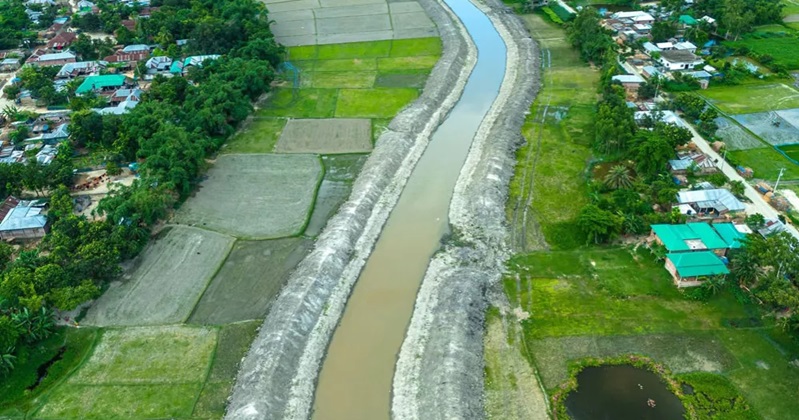Farmers’ fortunes rise as Rautnagar Canal revives Thakurgaon’s farmlands


Once a parched and flood-prone stretch of land, the Rautnagar Canal area in Thakurgaon’s Ranisankail upazila has been transformed into a thriving agricultural zone, thanks to its recent re-excavation.
The eight-kilometre-long canal, stretching from Sreepur Mouza in Ranisankail upazila to the Keutan Border Bridge, has breathed new life into local farming.
Nearly 25,000 acres of land that were once limited to a single crop now yield up to three harvests a year, marking a significant turnaround for thousands of farmers in the border region.
In addition to revitalising farmland, the project has also reclaimed around 30 acres of encroached government land, which will now be utilised for community development under official management.
For decades, the Rautnagar Canal stood as a shadow of its former self. Once a vibrant waterway supporting biodiversity and agriculture, it had gradually lost its flow, turning vast tracts of land into flood-prone zones during the monsoon.
Waterlogging was common, restricting cultivation to one seasonal crop, mainly Boro rice. During the dry months, the canal would run dry, leaving farmers with no irrigation and forcing many into months of unemployment.
“During the monsoon, our fields used to look like a pond. Crops would rot, and in winter there was no water for irrigation. Our ancestors could never imagine growing more than one crop a year. But now, we can cultivate three, and sometimes more,” recalled local resident Tota Mia.
The Water Development Board’s re-excavation project has brought about a visible transformation in both land and livelihoods. The restored canal now ensures proper drainage during heavy rains and provides irrigation water during the dry season, enabling continuous farming throughout the year.
Farmers are diversifying their crops, cultivating not only rice but also potatoes, wheat, maize, oilseeds, and high-value vegetables.
Officials from the Department of Agricultural Extension said that nearly 25,000 acres of farmland adjacent to the canal are now suitable for three-season cropping, potentially generating agricultural products worth hundreds of crores annually.
This surge in productivity has had ripple effects on the rural economy, boosting incomes, creating local employment and reducing the need for seasonal migration.
“Earlier, we had to go to Dhaka or Chattogram to find work,” said Shamsul Haque, 42, a local farmer, adding, “Now we can work on our own land throughout the year. We grow vegetables like cabbage, brinjal, and tomatoes along the canal. Life has changed.”
For farmers like Rafiqul Islam, 46, the change has been life-altering. “My parents never dreamed of growing more than one crop here. Scarcity was part of our lives. But now, I harvest three crops from the same land. My income has tripled, and I no longer worry about paying for my children’s education,” he said.
Local authorities are now taking steps to ensure the canal’s long-term preservation. Golam Zakaria, Upazila Executive Engineer, described the canal as ‘a symbol of sustainable rural development’.
He said new measures are being planned to maintain the natural water flow so that the benefits continue for generations. “The Rautnagar Canal is now more than a waterway—it is a symbol of new dreams, prosperity, and possibility.”
Alamgir Kabir, Additional Deputy Director (Crops) of the Thakurgaon Agricultural Extension Department, echoed this optimism, saying farmers are becoming more interested in modern agricultural practices and experimenting with high-yield varieties. “This project has sparked a new era for agriculture in the region,” he said.
With fertile fields, full irrigation and rising incomes, the people of Ranisankail are witnessing a long-awaited agricultural renaissance, one canal at a time.
